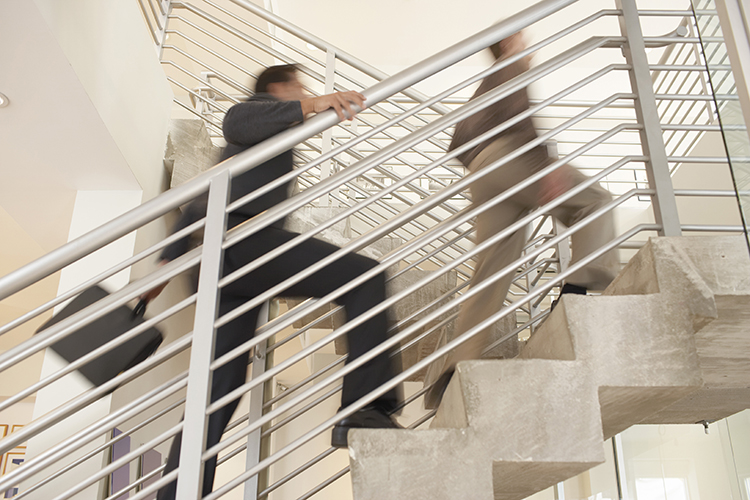
What do collaboration rooms, touchdown spaces, regeneration areas, greenery, and circadian lighting all have in common? They’re all part of what makes up the active workplace — office design with a focus on employee wellness.
Technology has made it possible for employees to get all their work done without ever leaving their desks. In fact we spend 70 percent of our working day sitting down. But there’s a price to pay for that convenience: insufficient levels of physical activity, which the World Health Organization recognizes as a leading risk factor for early death.
“This is very sad news when it comes to sedentary lifestyles,” says Ana Stanojevic, JLL’s Associate Director of Workplace Consultancy. “Sitting for long periods has become a big issue in the workplace. Some employers still associate productivity with people sitting at their desks, but in fact, companies and their employees can both see real benefits from moving around more during the day.”
“Although active design requires a carefully managed cultural shift it’s driven by a growing emphasis on improving employee wellness.”
Happier and healthier employees
The idea of getting employees to move isn’t a new one. “Activity-based working is a phenomenon that can trace its roots back 20 years,” says Stanojevic. And indeed, it was 10 years ago when Yvon Chouinard, founder of outdoor company Patagonia, wrote a book that became this company’s corporate manifesto: Let My People Go Surfing. If people need to go for a climb during the day, they can.
But getting out to exercise is not enough to offset the risk factor of sitting for too long. Instead, the idea is to get employees up and moving during the working day — and more frequently than the occasional trip to the water cooler. While some companies are trialing the likes of standing desks and treadmill desks, these can be expensive. But creating more active workplaces doesn’t have to involve refurbishing the office.
Instead, it’s more a case of getting employees moving by encouraging walking and standing during informal meetings – or even shifting the office furniture around a little. “Active design involves a more holistic view of how the office is used by supporting workplace aspects such as natural light, fresh air, and biophilia (the introduction of nature into the built environment); quiet rooms and contemplative areas; collaborative zones; and a design that fosters movement,” says Stanojevic.
“For example, to start with, businesses can integrate some of the simpler aspects like moving away things that used to be close to the desk, such as coffee or print areas,” says Stanojevic.
Encouraging people to use the stairs also helps with employee health. Instead of the dark and dingy stairwells that people avoid, many workplaces feature prominent and open staircases – with elevators hidden away. The Lentz Public Health Center in Nashville, for example, embraced this idea by creating artwork that changes with the motion of people using the stairs.
Opening up offices for active employees
Modern offices are increasingly adapting to a mobile and flexible workforce. Instead of expecting staff to remain at their desks all day, an open office allows employees to move around to suit their needs, from touchdown spaces where laptop users can gather for short periods to have an impromptu meeting to quiet zones for when people need to concentrate.
Some offices try to inject a little fun into social areas such as table football or table tennis as an added incentive to get employees away from their desks at lunchtime, while others have introduced workplace gardens. And with one in five employees working through lunch and half of people eating at their desk, according to the Chartered Society of Physiotherapy, the chance to unwind can make a big difference to how employees think and feel in the workplace.
As Stanojevic points out, “active office design isn’t about novelty or implementing more rules — it’s about helping to keep employees healthier and happier.”
Wellness programs, mindfulness, and meditation
Getting people moving is just one part of the wellness challenge that many companies are currently tackling. “Active design and wellness programs go hand in hand,” says Stanojevic. “They both focus on promoting health and reducing stress.”
Wellness programs are big in many companies, particularly in the US where containing medical costs is a key concern; about half of US companies offer them to try to combat the high health insurance premiums. Employers in Asia recognize that an investment in employee health pays off and many use health programs to attract the best in class talent.
Mental health is also a key area as the modern workplace requires employees to juggle more tasks than ever before. “The always-on workplace culture, hyper-connectivity and the addiction to smartphones, has made mindfulness more needed than ever before,” says Stanojevic.
And companies are taking notice: chill out areas and lunchtime classes are becoming more commonplace as companies realize that helping their employees to relax can boost productivity and create a better workplace for all.
“The overall environment of an active design office is very vibrant, and companies are just now scratching the surface,” says Stanojevic. “While Europe and the U.S. are taking the lead on this, it’s really refreshing to see the changes starting across other cultures and regions as well.”
From: JLL Real Views
